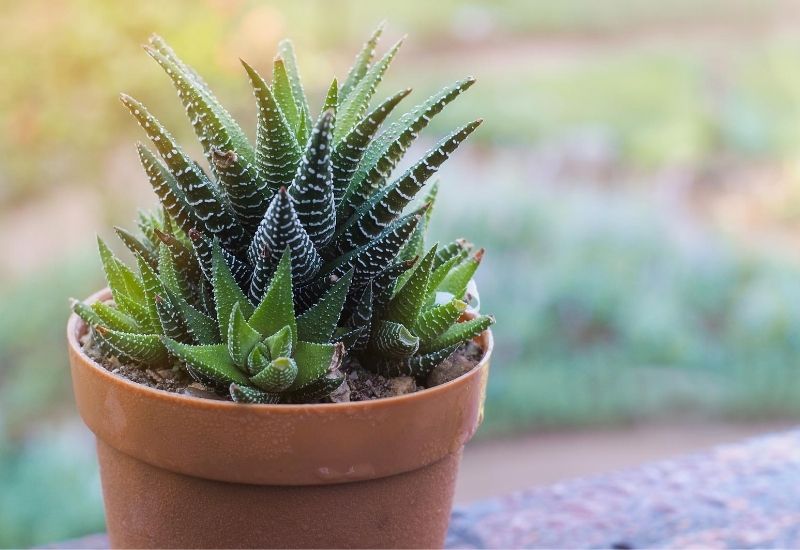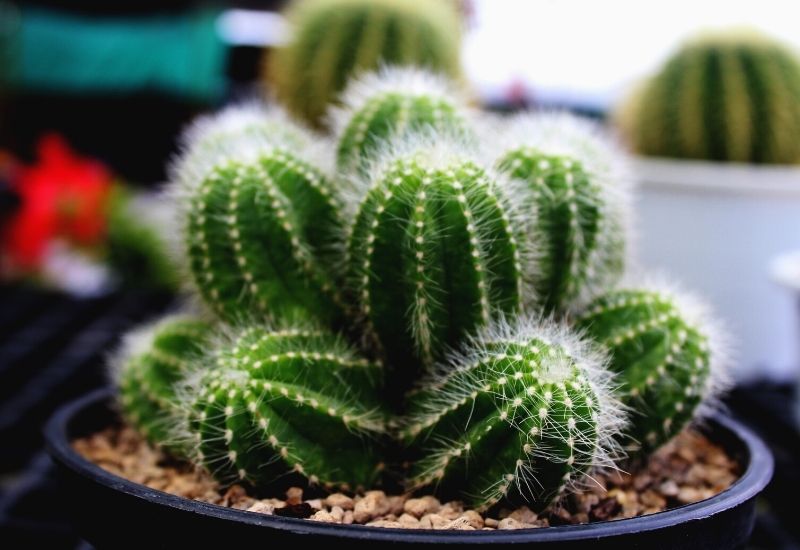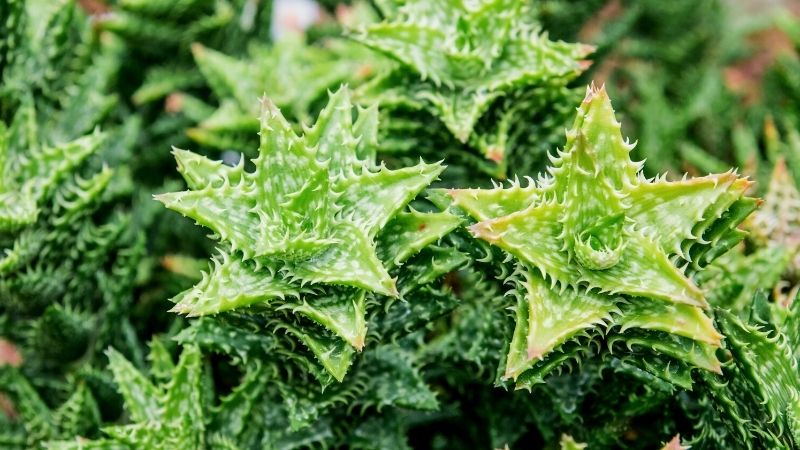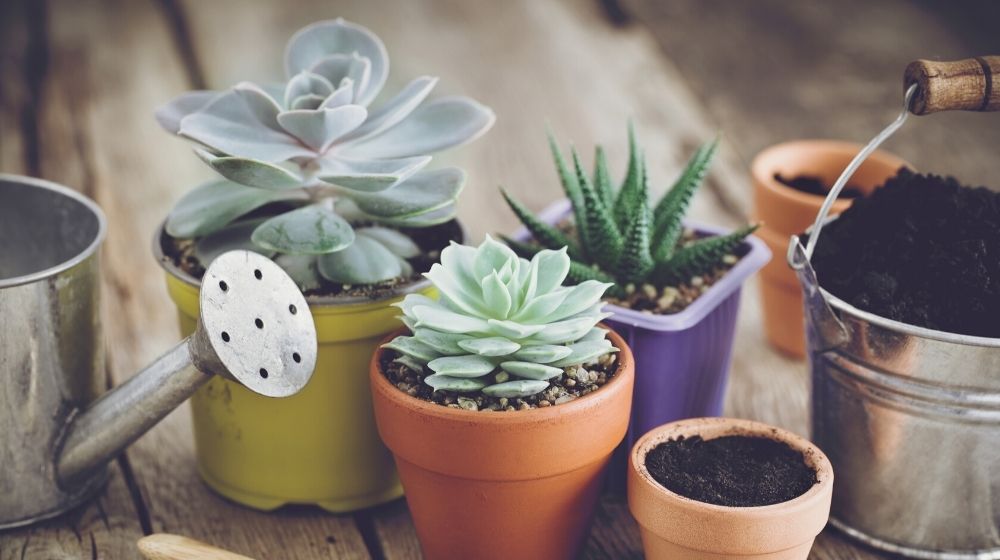There are so many types of succulents to love, and getting to know more about them can be fun and interesting.
They are beautiful and easy to grow and propagate. Here is a list of the different types of succulents and their unique features!
RELATED: The Best Pots and Soil For Succulents | Everything You Need To Know
Types of Succulents You Can Choose From for Your Garden
1. Aloe Vera
Aloe vera is a succulent species most known for its medicinal benefits. It has pointed thick leaves with gel inside, proven to give natural relief for skin problems and hair loss.
Aloe vera grows better indoors in bright and indirect light. Water more, but not frequently.
2. Jade Plant (Crassula ovata)
Jade plant, known as money tree and lucky plant, is also the bonsai of the succulent family. It has shiny and thick oval green leaves attached to its thick branches and trunks that look like a miniature tree.
With proper care and the right condition, the mature plant will give you lovely pink or white flowers that look like stars.
3. Zebra Plant (Haworthia fasciata)

Zebra plant got its name from the white stripes on its leaves resembling that of its animal counterpart. Its dainty appearance and unique leaf patterns make it a lovely decor for your desk or bookshelf.
This succulent is perfect for first-time plant parents since it requires little to no care. However, their root system is shallow which lets them grow best in smaller pots.
4. Hens-and-Chicks (Sempervivum tectorum)
Hens-and-chicks are commonly called houseleeks because they thrive well both indoors and outdoors. This succulent can propagate easily and produce clusters of rosettes called the “chicks.”
They come in a wide array of colors and have leaves with flat and rounded edges forming a flower-like pattern that will add a feminine touch to your garden and home display.
5. Panda Plant (Kalanchoe tomentosa)
Panda plant, also known as pussy ears or cocoon plants is a native in Madagascar. It has small, fuzzy, silver-gray leaves with rusty markings on the edges which make it an interesting indoor plant.
This succulent plant loves direct sunlight for a few hours a day. It also loves being watered thoroughly but not frequently.
6. Burro's Tail (Sedum morganianum)
@plantashopJust re-stock our Burro’s Tail Succulents! 🙌🏼 ##smallbusiness ##fyp ##succulents ##homedecor ##plantlover ##plant ##obsessedwithit ##burrostail ##cactus♬ Sunset Lover – Petit Biscuit
Burro's tail or donkey tail plant has the ability to grow up to four inches tall with a form that resembles a tail. This succulent is drought-tolerant and well suited for warm weather conditions.
If you love hanging plants, burro's tail can help you add charm to your garden. Keep in mind that the leaves fall off easily, so consider placing burro's tail in a spot where there is minimal to no disturbance.
7. Snake Plant (Sansevieria trifasciata)
Snake plant, also known as the mother-in-law's tongue, is one of the most popular indoor plants today. Aside from easy to grow, snake plants can also add vertical interest to every corner of your home.
It can tolerate neglect, so if you're the type of parent who often forgets to water your plants, this is the perfect type of succulents for you!
8. Jelly Bean Plant (Sedum rubrotinctum)
Jelly bean plant or pork and beans originated in Mexico. It has green leaves that look like jelly bean candies which turn into a lovely rainbow of pink, yellow, and red when exposed to the sun.
They can also produce star-shaped flowers with bright yellow hues throughout the spring season. Not only are they low-maintenance, but they are also easy to propagate.
9. Ball Cactus

Ball cactus or parodia is native to central South America with a globular and sometimes a barrel shape. Older and mature parodia will produce flowers usually in yellow, pink, red, or orange.
All species of ball cactus are ribbed with clusters of spines which makes them easy to identify. Unlike many types of succulents, these cacti are not fond of the full sun, especially during the warmer months.
RELATED: 17 Summer Landscape Ideas And Tips For Your Summer Garden
10. Topsy Turvy Echeveria (Echeveria runyonii)
Topsy turvy is an evergreen succulent with long leaves forming a rosette pattern. Each tip of the leaves slightly flicked back pointing to the center of the rosette.
During the summer season, topsy turvy bears out long stems with flowers that look like stars. Just like most succulents, you need to allow the soil to dry out completely before watering.
11. Crinkle-Leaf Plant (Adromischus cristatus)
Crinkle-leaf plant or key lime pie is a low-growing succulent with green to gray foliage covered with tiny hair. The leaves are thick and triangular in shape with crinkled edges.
Like most types of succulents, this plant likes to be kept very dry compared to most succulents. This is the perfect type of succulent for beginners since it is easy to grow and doesn't enjoy babysitting.
12. Aloe juvenna (Tiger Tooth Aloe)

Aloe juvenna is notable for its clump of triangular leaves that are green in color with white markings and spikes. Considered as an unusual succulent, it has thick stems that can extend up to 2 ft. long.
13. Bunny Ear Cactus (Opuntia microdasys)
This paddle cactus is also commonly called the angel's wings. A favorite among houseplants, both indoors and outdoors, it is easy to grow and looks so adorable with its several pads.
Reminder: Always wear a pair of garden gloves to protect your skin from glochids that can easily spread on your body and trigger irritations. Glochids are hair-like spines found on the areoles of cacti.
14. Coral Cactus (Rhipsalis cereuscula)
Coral cactus or rice cactus originated in South America, and grows beneath the trees in its native habitat in Brazil. It has green bushy stems that can grow long and thin spreading out the edge of its pot.
You can place it in hanging planters for striking trailing plants inside your home. You also don't have to worry about the spikes because they're soft and safe to touch.
15. Moon Cactus (Gymnocalycium mihanovichii)
@sheprojectsMoon cactus polyp graft ☺️##cactus ##cacti ##mooncactus ##succulent ##succulents♬ Closer – Goapele
Moon cactus is a great indoor plant for beginners. It also has a bizarre look which is the result of grafting two separate cacti species together.
The colorful graft on top is a Gymnocalycium while the rootstock cactus comes from another plant such as Hylocereus.
What is Gymnocalycium? Commonly called chin cactus, is a genus of about 70 South American species of cactus. The genus name Gymnocalycium (from Greek, “naked calyx”) refers to the flower buds bearing no hair or spines
What is Hylocereus? The species of the genus Hylocereus grow hanging, climbing or epiphytic. They are freely branched, shrubby plants that form aerial roots and become very large with a height of 10 m or more. They are green, often glaucous shoots are usually terete or triangular.
16. Cushion Aloe (Haworthia cooperi)
The Haworthia cooperi plant is widespread in South Africa. It does best in bright but indirect light for a couple of hours a day.
The stems of this slow-growing succulent have transparent tips enabling light to pass that makes it striking and look like something out of this world.
17. Fishbone Cactus (Epiphyllum anguliger)
Fishbone cactus is well known for its long stems with its distinct zig-zag look. It's hardy and can add a visual appeal to any home landscape. It will look gorgeous in a hanging basket or your work desk.
This plant bears oval-shaped fruit with a greenish surface.
18. Lithops
@lithop.socuteสวยมากแม่ อยากขะไปนอนกลิ้งอยู่บนเจ้าไลทอป ##lithops ##ไลทอป ##ไลทอปเด็กหัวสี ##ไลทอปก้อนหินมีชีวิต♬ IM NEED SOMEBODY – Radia🦋✨
Lithops, also known as living rocks, belongs to the ice plant family, Aizoaceae. Its stone-like appearance makes it very unique. A cluster of lithops in a wide planter can be a lovely display in your home.
Most lithops produces daisy-like blooms from the fissure between the leaves during autumn and early winter.
19. Sand Dollar Cactus (Astrophytum asterias)
Sand dollar is a small cactus plant with little fluff balls around its surface called areolas. This is great for cactus lovers who are looking for a cute and spineless option.
Another reason to love this plant is that they are low maintenance, yet will reward you with dainty flowers in the colors yellow, white, pink, and red.
Watch this video by The Lawrence Garden Farm on how to plant and water succulents plus more tips on growing succulents at home:
Indoor plants such as cacti and succulents became trendy and popular today! They are easy and fun to grow, low-maintenance, and can add a lovely aesthetic to your garden.
The different types of succulents come in different shapes, colors, and sizes–all of which have their unique characteristics. Knowing them will help you understand these fleshy and juicy plants even more!
Which among these types of succulents is your most favorite? Let us know in the comments section below.
Up Next:
- Plant a Living Picture With A Succulent Vertical Garden
- How To Make A Succulent Wreath | Garden Season Decor Ideas
- How To Build Your Own Hydroponic Tower Garden
Calling all green thumbs, Garden Season needs YOU!
Click here if you want to write for us!
Want to stay up to date? Follow Garden Season on Facebook, Twitter, Instagram, and Pinterest.



